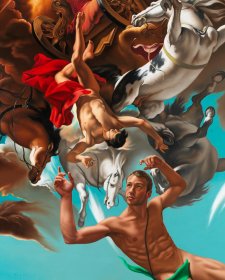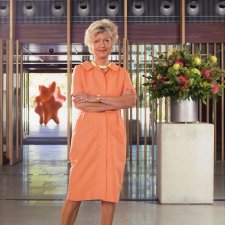Temporary road closures will be in place around the Gallery from 26 February during the Enlighten Festival.
The relationship between Richard Larter and Pat Larter (1936–1996) has been described as 'one of the liveliest and most productive art partnerships in Australia.' English by birth, they married in London in 1953 and emigrated to Sydney in 1964. Richard found work as an art teacher, after which the couple settled with their five children at Luddenham in south-western Sydney. According to Richard, the Sydney art scene at the time 'represented the worst trends seen in a pre-world war II backwards looking Royal Academy'. He soon disrupted this with vivid, anarchic paintings that embraced both figuration and abstraction, were often executed in a range of experimental techniques, and which also incorporated pop-culture elements, such as brightly coloured heads of celebrities, dictators and sex symbols. From the mid-1960s onwards, Pat Larter collaborated with Richard in numerous works that defiantly mocked conservatism and hypocrisy – such as this work, which satirises the commodification and objectification of women in pornography and popular visual culture. Though formerly thought of primarily as Richard's muse, Pat was as often as not the animating force behind their collaborations, and later emerged as artist in her own right. Her practice encompassed performance, painting and photo-media, and she was a leading, stridently feminist figure in the international mail art movement. She held her first solo exhibition in Sydney in 1992 and thereafter exhibited regularly, both singly and in group shows, until her untimely death from cancer in 1996.
Gift of Patrick Corrigan AM 2008
© Richard Larter/Copyright Agency, 2024
Pat Painting No 1 is of performance artist Pat Larter, with another female face behind her, made by Pat’s husband, Richard Larter in 1983. The portrait is in synthetic polymer paint on canvas, and measures about 1.8 m tall by 1.25 m wide, and is surrounded by a light-coloured wooden frame.
A bold and dynamic background surrounds the two figures. It is made from a geometric patchwork assemblage of many brightly-coloured and contrasting striped segments, including; pink, purple and blue; orange, blue and white; and green, purple and yellow.
The two women are rendered in vibrant colour and multidirectional lines, textures and patterns. Their faces occupy the full top half of the image. In the foreground Pat Larter faces us directly, her bare chest filling the lower part of the painting. The edges of her shoulders, as well as her breasts, are cropped and not in view. Behind Pat, on our right, appears another woman. The right side of her head and chest are partially obscured by Pat’s image and she gazes out to her left and beyond the frame.
The hair of the woman behind Pat is painted in hatched diagonal yellow lines arranged on top of her head, featuring a dark brown section towards the front. She has almond-shaped, light brown eyes beneath thin penciled eyebrows, and a rounded nose. The shadows on both sides of her face and neck are detailed in pale brown hatched lines. Her full lips are pursed into a pucker, painted a vivid crimson red, the colour matching a glimpse of the garment covering her left shoulder. Around her neck is a necklace of small round yellow beads.
Pat Larter is created with the same lines, made into cross-hatched patterns, but rendered with more delicacy. Her straight dark hair is cropped short. It is textured with evenly spaced horizontal, vertical and diagonal hand-applied lines in black, blue, and pink. Wisps of fringe point downward to fine eyebrows, arching above her eyes. The bold blue colour of Pat’s eyes dazzle against the complex patterns, matched in intensity by her red lips. The lips are parted to reveal seven white, evenly spaced, lower teeth. Her tongue curls around her upper teeth to touch her top lip in the centre. Her neck is adorned in a long necklace of large, round, white beads.
Audio description written by Meredith Hughes and voiced by Lucie Shawcross, 2021
Patrick Corrigan AM (130 portraits)



On one level The Companion talks about the most famous and frontline Australians, but on another it tells us about ourselves.



How seven portraits within Bare reveal in a public portrait parts of the body and elements of life usually located in the private sphere.



Portraits of philanthropists in the collection honour their contributions to Australia and acknowledge their support of the National Portrait Gallery.